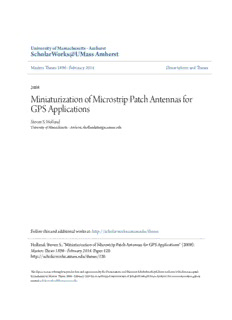Table Of ContentUniversity of Massachusetts Amherst
ScholarWorks@UMass Amherst
Masters Theses 1911 - February 2014
2008
Miniaturization of Microstrip Patch Antennas for
Gps Applications
Steven S. Holland
University of Massachusetts Amherst
Follow this and additional works at:https://scholarworks.umass.edu/theses
Part of theSignal Processing Commons
Holland, Steven S., "Miniaturization of Microstrip Patch Antennas for Gps Applications" (2008).Masters Theses 1911 - February 2014.
120.
Retrieved fromhttps://scholarworks.umass.edu/theses/120
This thesis is brought to you for free and open access by ScholarWorks@UMass Amherst. It has been accepted for inclusion in Masters Theses 1911 -
February 2014 by an authorized administrator of ScholarWorks@UMass Amherst. For more information, please contact
[email protected].
MINIATURIZATION OF MICROSTRIP PATCH ANTENNAS FOR GPS
APPLICATIONS
A Thesis Presented
by
STEVEN S. HOLLAND
Submitted to the Graduate School of the
University of Massachusetts Amherst in partial fulfillment
of the requirements for the degree of
MASTER OF SCIENCE IN ELECTRICAL AND COMPUTER ENGINEERING
May 2008
Electrical and Computer Engineering
© Copyright by Steven S. Holland 2008
All Rights Reserved
MINIATURIZATION OF MICROSTRIP PATCH ANTENNAS FOR GPS
APPLICATIONS
A Thesis Presented
by
STEVEN S. HOLLAND
Approved as to style and content by:
__________________________________________
Daniel H. Schaubert, Chair
__________________________________________
David M. Pozar, Member
__________________________________________
Marinos N. Vouvakis, Member
________________________________________
C. V. Hollot, Department Head
Electrical and Computer Engineering
To my parents.
ACKNOWLEDGMENTS
I would like to thank my advisor, Dr. Schaubert for giving me the opportunity to
perform research under his guidance. His patience, advice and support have allowed me
to explore, learn, and become a better engineer. I would also like to thank my
committee members, Dr. Pozar and Dr. Vouvakis for their many discussions and
insightful comments that contributed greatly to the success of this thesis.
I would also like to thank Tyco Electronic Systems Division for funding this
project and for fabricating and testing the prototype antennas. I am indebted to the
engineering team members: Tom Goodwin, Tom Lavallee, Mark Marden and Tom
Rose, whose suggestions were extremely helpful in developing the designs.
My colleagues in the Antennas and Propagation Laboratory have been invaluable
in both their technical and moral support. The many discussions I have had with them
helped tremendously with the computational tools, measurements, and in furthering my
understanding of antennas and electromagnetic phenomena. Particular thanks go to
Justin Creticos, Sreenivas Kasturi, Andrew Mandeville, Eric Marklein, and Georgios
Paraschos. Finally, the support of my family and friends has been pivotal in the
completion of this thesis.
v
ABSTRACT
MINIATURIZATION OF MICROSTRIP PATCH ANTENNAS FOR GPS
APPLICATIONS
MAY 2008
STEVEN S. HOLLAND, B.S.E.E., MILWAUKEE SCHOOL OF ENGINEERING
M.S.E.C.E., UNIVERSITY OF MASSACHUSETTS AMHERST
Directed by: Professor Daniel H. Schaubert
The desire to incorporate multiple frequency bands of operation into personal
communication devices has led to much research on reducing the size of antennas while
maintaining adequate performance. GPS is one such application, where dual frequency
operation, bandwidth and circular polarization pose major challenges when using
traditional miniaturization techniques. Various loading methods have been studied to
reduce the resonant frequency of the antenna – high permittivity dielectric loading, slot
loading and cavity loading – while examining their effects on bandwidth and gain. The
objective of this thesis is to provide guidelines on what is achievable using these
miniaturization methods and insight into how to implement them effectively.
vi
TABLE OF CONTENTS
Page
ACKNOWLEDGMENTS ................................................................................................ v
ABSTRACT ..................................................................................................................... vi
LIST OF TABLES ........................................................................................................... ix
LIST OF FIGURES ........................................................................................................... x
CHAPTER
1. INTRODUCTION................................................................................................. 1
1.1 Background of Microstrip Antennas ......................................................... 1
1.2 Motivation for this Study .......................................................................... 2
1.3 GPS Antenna Challenges .......................................................................... 2
1.4 Overview of Thesis ................................................................................... 4
2. SMALL ANTENNA CONSIDERATIONS ......................................................... 6
2.1 Quality Factor Considerations .................................................................. 7
2.2 Gain Considerations ................................................................................ 15
2.3 Recent Research on Electrically Small Antennas ................................... 18
3. LOADING METHODS ...................................................................................... 22
3.1 High Permittivity Dielectric Loading ...................................................... 22
3.1.1 High Permittivity Performance Trends ...................................... 26
3.1.2 Optimized Linearly Polarized Prototype Design ....................... 29
3.1.3 Optimized L-probe, CP Stacked Patch Prototype ..................... 37
3.2 Slot Loading ............................................................................................ 47
3.2.1 Slot Loading Performance Trends ............................................. 51
3.2.2 Optimized Slotted, Stacked Patch Design ................................. 62
3.3 Cavity Loading ........................................................................................ 66
3.3.1 Cavity Loading Performance Trends ......................................... 69
3.3.2 Optimized Cavity Backed, Stacked Patch Design ..................... 80
vii
4. CONCLUSION ................................................................................................... 85
APPENDICES
A. DERIVATION OF MINIMUM Q LIMITS ........................................................ 87
B. ADDITIONAL ANTENNA DESIGNS .............................................................. 91
C. HFSS CONDUCTIVITY CONSIDERATIONS ................................................ 94
D. SLOT MAGNETIC FIELD VECTOR PLOTS ................................................ 104
E. MEASURED SLOTTED PROTOTYPE ANTENNAS ................................... 106
F. EQUIVALENT CIRCUIT FOR WIDE SLOTS ............................................... 113
G. CAPACITOR LOADED PATCH ANTENNA ................................................ 114
H. EFFECT OF SUBSTRATE THICKNESS ON RESONANT
FREQUENCY ................................................................................................... 117
I. VERTICAL WALL LOADED ANTENNA ..................................................... 118
BIBLIOGRAPHY ......................................................................................................... 121
viii
LIST OF TABLES
Table Page
1- Comparison of the 2:1 VSWR bandwidth for three different slot shapes. ........... 59
2 – Summarized results of the measured and simulated data. All simulations
run on 64 bit WinXP, 2.4GHz Intel Core 2 Duo system (two
active cores) with 4GB of RAM. ............................................................ 97
3 – Summary of comparison between simulated and measured data using
different HFSS conductivity settings. * indicates 2mm maximum
element size, **indicates 0.5mm maximum element size. All
simulations run on 64 bit WinXP, 2.4GHz Intel Core 2 Duo
system (two active cores) with 4GB of RAM. ...................................... 100
ix
Description:Holland, Steven S., "Miniaturization of Microstrip Patch Antennas for GPS Applications" (2008). Masters Theses 1896 - February 2014. Paper 120.

